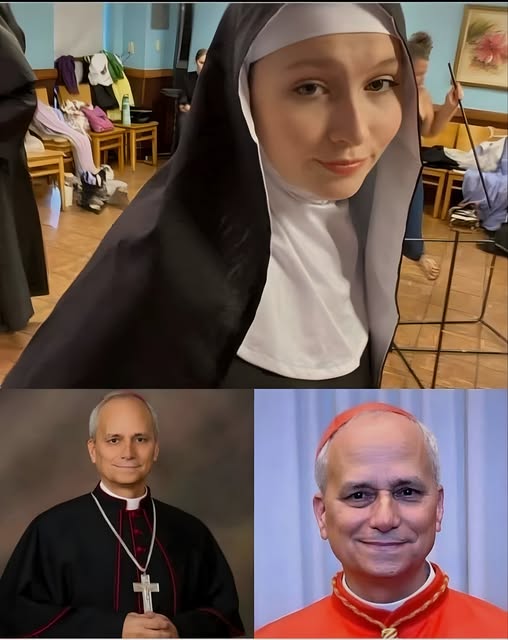In today’s rapidly changing world, religion no longer exists in isolation. Once protected by ritual, authority, and centuries of tradition, it now faces public scrutiny, digital transparency, and the relentless momentum of modern thought. The Church—especially the Vatican—stands at the crossroads between ancient faith and contemporary culture. The tension between these spheres is no longer theoretical; it is visible, undeniable, and transformative.
At the heart of this transformation is an image—both literal and symbolic. A cardinal, draped in scarlet robes, embodies centuries of spiritual authority, intellect, and ritual. Beside him stands a woman: confident, modern, her identity deliberately ambiguous. Together, they portray a dialogue—a meeting point between authority and reform, between age-old certainties and contemporary accountability.
Her gaze is unwavering, unapologetic. His, measured and inward, carries the weight of history. Between them, the word “FORGIVENESS” emerges—bold and unmistakable. It is at once a challenge and an invitation.
The Tension Between Past and Present
This image is more than a portrayal of religion; it is a mirror reflecting the institution itself. For centuries, the Catholic Church has been a pillar of continuity—a guardian of moral codes and ritual. Yet in recent decades, crises have tested its moral authority like never before. Scandals, abuse, cover-ups, and systemic failures have shaken the Vatican’s foundation, eroding trust and forcing profound introspection.
Where faith once quelled doubt, today’s believers freely question. The Church, long accustomed to teaching, is now being asked to listen. The woman in the image is not an antagonist; she represents that demand—the world outside the Vatican walls calling for transparency, equality, and change.
The bowed figure of another cardinal in the scene captures a moment of reckoning. His humility contrasts with the institution’s historical posture of power. This is not submission—it is acknowledgment. It represents the understanding that faith can no longer rely on doctrine alone; it must coexist with accountability.
Forgiveness: The Double-Edged Virtue
Forgiveness has always been central to Christian teaching—a divine command, a moral imperative. Yet in the modern world, it carries added complexity. When misused, forgiveness can shield wrongdoing and circumvent responsibility. True forgiveness, however, requires acknowledgment of wrongdoing and active efforts to repair the damage.
The Church’s challenge is to transform forgiveness from ritual into meaningful reform. Public apologies are hollow without institutional change. When a cardinal bows his head in symbolic humility, the gesture carries weight—but only if followed by genuine action. Forgiveness cannot erase history; it can only guide what comes next.
The depiction of “FORGIVENESS” thus resonates beyond theology—it becomes cultural. It demands reconciliation between faith and its followers, between authority and the people it serves. It asks: Can centuries-old institutions evolve without losing their essence?
Tradition Under Pressure
The modern era has compelled religion to redefine its role in public life. Faith leaders can no longer preach without engaging with issues of gender, sexuality, politics, and justice. The woman in the image embodies these realities—she is not rebellion for its own sake, but representation. Her presence beside the cardinal signals the growing insistence that women have a voice in spiritual spaces that historically excluded them.
Her confidence contrasts with the ornate austerity of the Church hierarchy. Yet there is no hostility in her stance—only assertion. She reminds that for faith to endure, it must make room for humanity in all its forms. The Church can no longer act as though the modern world exists outside its walls.
The tension between these figures—the modern and the traditional, the questioning and the ordained—is not destructive; it is necessary. Without friction, there can be no progress. The Catholic Church, like all longstanding institutions, faces a choice: cling rigidly to the past or evolve toward what is needed.
The Cultural Meaning of Change
This interplay of tradition and transformation reflects a broader cultural reality. Religion is not disappearing; it is being redefined. Across the world, younger generations may reject rigid institutions but not faith itself. They seek meaning, connection, and purpose—but demand honesty and inclusivity instead of authority and control.
The silent dialogue between the cardinals and the woman captures this paradox. The sacred and the secular are not adversaries—they are collaborators in an ongoing moral conversation. Forgiveness, once confined to confessionals, now unfolds publicly: through truth commissions, apologies, and transparency.
Modern forgiveness is not about forgetting sins; it is about confronting them. It requires courage to acknowledge failure and rebuild something stronger in its place.
The Path Forward: Humility as Strength
The Catholic Church, and religion in general, face a critical moment. To remain relevant, it must embrace vulnerability. Humility, long preached but rarely practiced by leadership, has become essential to survival.
The bowed cardinal symbolizes this emerging awareness. His lowered eyes are not defeat—they reflect introspection. They show a willingness to face pain rather than deny it. Through humility, the Church can reconnect with its original strength: service, compassion, and recognition that even divinely inspired institutions are run by humans.
Forgiveness, then, becomes the bridge between divine aspiration and human imperfection. It is where Church and society meet—not as adversaries, but as participants in a shared moral journey: to heal, to learn, and to evolve.
A Final Reflection
The Vatican may tremble, but tremors often precede renewal. This image captures not the collapse of faith, but its transformation. The scarlet robes retain their weight, yet now stand alongside new symbols—womanhood, equality, and truth.
If the Church can embrace listening over commanding, confession over concealment, it may emerge stronger—its faith purified by honesty rather than power.
Ultimately, this is not only a story about religion. It is about all of us—our need to reconcile tradition with progress, authority with empathy, and belief with accountability. Within that tension lies the possibility of something sacred reborn: not a church of stone, but one built on humility, forgiveness, and courage.
In the end, that is the true revelation shaking the Vatican—not scandal, but a chance for redemption.
